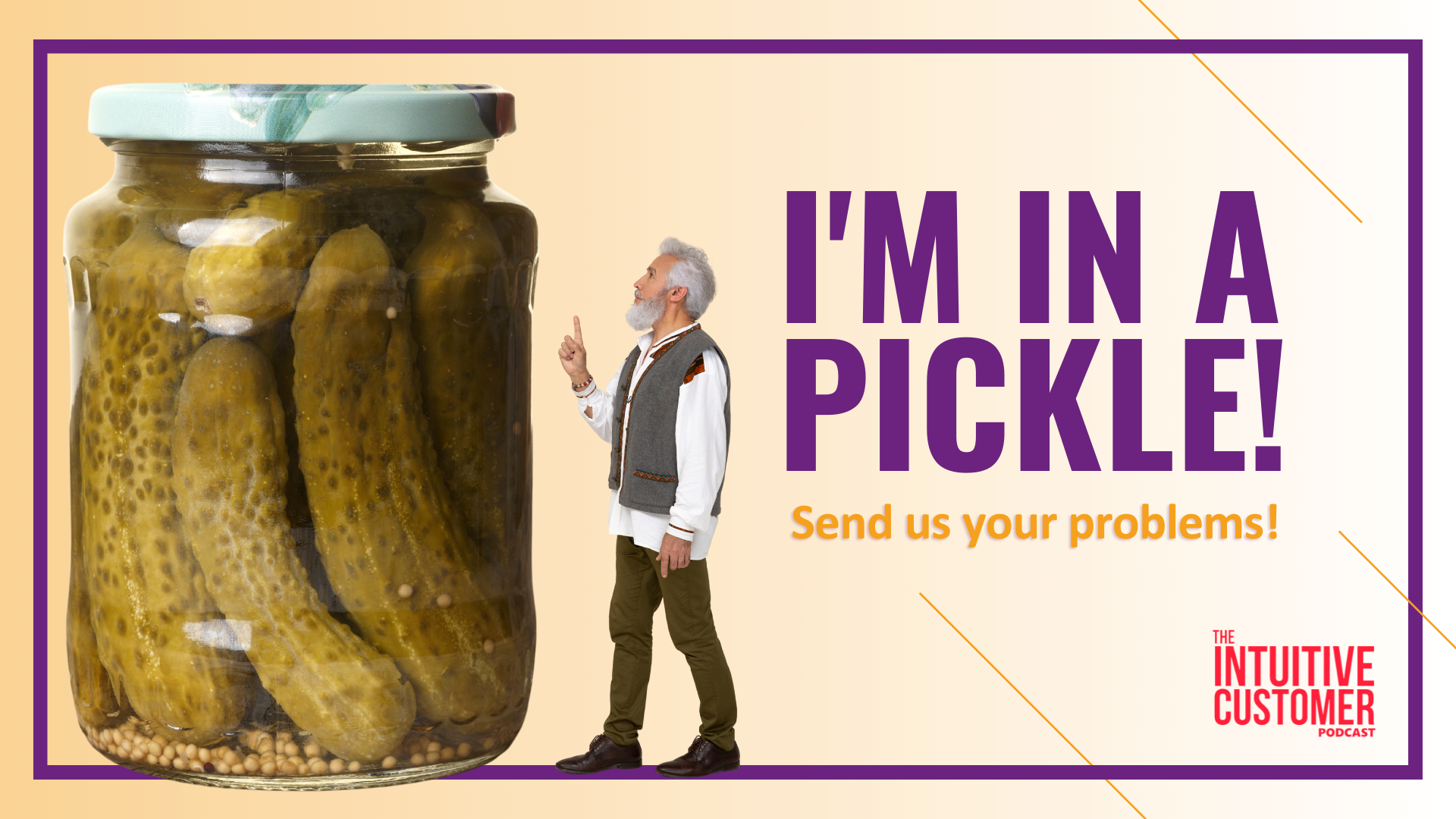Journey mapping can be a tricky thing for organizations. Organizations often think that doing a journey map of their experience will be the answer to life, the universe, and everything.
But it isn’t.
If we think about why we do journey mapping, one of the big reasons is to alleviate blind spots within the team. Once we map out the journey, we start to see, “Oh, we have all these ways that we interact or could interact with our customers and all of those things to find the experience.” So to me, it is a way to find the answer to life, the universe, and everything, but not the answer itself.
One of our listeners in Finland, Anna, is in a pickle. On a recent podcast, Anna called into the I’m In a Pickle feature to use their journey mapping exercise findings effectively. She also wants to know how to set up their Customer Experience improvement for success to be more customer-centric. The organization sees it as an integral part of their business, not something soft, fluffy, and easy to cut later. Since many of you might have the same problem, I thought I would also address this issue here.
How to Operationalize Journey Mapping

- The rational experience: This part is what the customer is doing, and it should be guesswork. You should know or have your customers tell you themselves. You have to observe the customer and get inside of their head.
- The emotional experience: How the customer feels throughout is essential. You can learn this by asking customers or by observing customers.
- The subconscious experience: Every experience has messages that the customer receives unconsciously.
- The psychological experience: The behavioral sciences live here, coming out in customer behavior.
In one of my books, Revolutionize Your Customer Experience, I delved into research about the nine internal areas that affect Customer Experience. We discussed these on the podcast in a series, and they include:
You can use each area to determine how Customer-Centric your organization is on a model we call Naïve to Natural. The four types of organization are:

In Anna’s case, I would start with a simple exercise to get the journey map off to a good and practical start. Anna’s company should begin by considering why the customer is entering the experience and how they feel when they arrive. The emotional state of customers is essential to understand if you want to manage the experience to a successful outcome.
For example, Beyond Philosophy did some work with a mobile phone company’s lost and stolen process. If you think about those two areas, lost and stolen, the customer’s emotional state could be quite different. The customer who lost their phone in the back of a cab feels stupid. The customer who just had the phone stolen feels scared and angry. Framing this situation in terms of Naïve to Natural, a Naïve or Transactional company would start the operational process to get the customer serviced, probably by asking for an account number. However, an Enlightened or Natural company would first ensure that the customer is okay before beginning the customer process.

Once we sorted that out, we met the third-party tow operator who came to pick up the wrecked vehicle. He loaded the car, but he didn’t give us a receipt. So, we asked for one. He reached into the cab, pulled out a greasy McDonald’s bag, tore off a piece, and wrote his phone number on it.
After handing us our “receipt,” the tow operator asked where we lived so he could take us home. However, we lived 100 miles away. The office was six miles away, so we asked if he could drop us there instead. Is anybody surprised that the answer was no? However, after a ten-minute conversation, we convinced him.
When we relayed this to the CEO and board, they put their heads in their hands. But, the fact is, knowing how people feel throughout the experience is essential to making journey mapping an effective and operational tool.
Managing Change for Your Organization
People have habits, and organizations do, too. To make your Customer Experience program work, you will need to change old habits and instill new ones for the changes you propose for the experience to occur in the organization.
Have you ever tried to change a habit, maybe about diet and exercise? If you have, then you know it’s challenging. Changing the habits of a person is one thing. Changing the habits of an organization is another and just as problematic.
Part of Anna’s question about operationalizing journey mapping for her organization involves change management. Dr. John Cotter, the author of Leading Change, has an 8-step process that can help here. The eight steps are:
- Create a sense of urgency.
- Build a guiding coalition.
- Form a strategic vision and initiatives.
- Enlist a volunteer army.
- Enable action by removing barriers.
- Generate short-term wins.
- Sustain acceleration.
- Institute change.
I like Cotter’s list because it’s mostly preparation. Change comes at the end of that list. In other words, most of the success in changing organizations is laying the proper groundwork and motivating and forming a coalition.
Avoiding the Soft and Fluffy Label

In other words, what people say and do evokes emotions that drive customer behavior. Therefore, organizations should recognize that managing emotions is essential for customer strategy. So, even if emotions seem like soft and fluffy things, they lead to concrete changes and actions within the organization that generate those emotions.
It is vital to know what customers want and expect from you. However, asking customers is not enough. People rarely say, “I want you to appreciate my business,” or “I want to feel like I matter as a person.” But they do. It’s your job to figure these things out, whatever they are, and give them to customers. Naïve and Transactional companies probably wouldn’t, but Enlightened and Natural companies would.
Perhaps most importantly for Anna, I would advise the organization to measure the return on investment for managing emotions to a valuable outcome. In addition, it would help if you had a baseline to compare it properly, which should happen before the journey mapping exercise. With these data points in place, you can prove to your team and senior management that the soft and fluffy emotional stuff is working.
So, What Are The Practical Steps?
Anna wanted practical steps for her company, so, to that end, here are a few that can guide their process improvement.
- Focus on the fact that you need to drive value. The reason that your organization is doing this is that they want to get more loyal customers. They want to get more revenue. They want to upsell, cross, sell, whatever. So, it would help if you defined the things that drive or destroy value for your organization. We use the Emotional Signature®, which is research that helps find what these value drivers are. You could spend all your time and effort redoing all the journeys, but if you’re not focusing on the things that customers derive value from, then you’re wasting your time.
- Define what the experience is. What are you doing today? What do you want to do? Then, after you answer these questions, you can set the strategy and start journey mapping.
- Train your people on how to implement that journey mapping. The customer-facing team must understand how to evoke the emotions necessary in the experience to drive value. From contact centers to marketing teams to accounting, everyone should know how to do this for customers.
- Look at the measures and design new ones. And guess what? If you’re measuring, you need to determine how the emotions are working for the things that drive value for your organization.
Perhaps the most important practical advice I can offer Anna or any company with this problem is to remember that this tool is designed to do something else. The goal is not to have a journey map. The goal is to have something that will solve a problem. So, when we’re creating our journey maps, keep in mind that we’re looking to get customer insights out of this to take specific actions.
Do you have a business problem, too? Don’t hesitate to contact us to tell us about it. Then, we may solve it with you and our listening audience on the podcast!

Think reading is for chumps? Try my podcast, The Intuitive Customer instead. We explore the many reasons why customers do what they do—and what you should do about it. Subscribe today right here.



